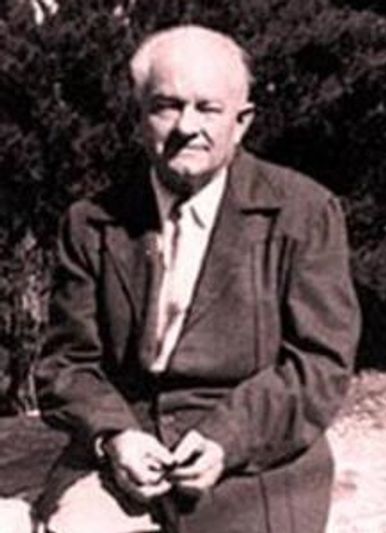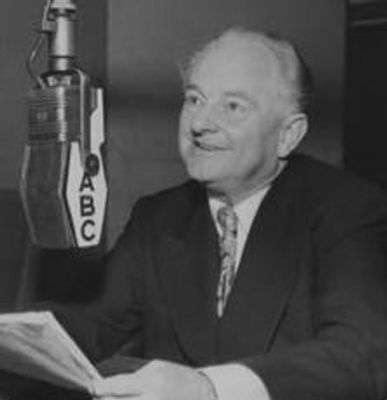Our Founder

Rev. Dr. Ernest Shurleff Holmes
From Sermon by the Sea (1959):
"... We have rediscovered that which the great, the good, and the wise have sung about and thought about the imprisoned splendor within ourselves and within each other — and have direct contact with it. Whether we call it the Christ in us, or the Buddha, or Atman, or just the Son of God the living spirit, makes no difference. You and I are witness to the Divine fact and we have discovered an authority beyond our minds, even though our minds utilize it."
This from a man born in 1887 who later inspired the “positive thinking” of Norman Vincent Peale, Peggy Lee, Cary Grant, Cecil B. DeMille, and countless others without ever intending to create a religion or a following of masses of people. He simply had a brilliant mind and wished to synthesize the writings of the times into one volume, which became the Science of Mind textbook, and was inspired by the teachings of Ralph Waldo Emerson, Judge Thomas Troward, and mystic Emma Curtis Hopkins. He discovered that affirmative prayer containing specific elements of recognition, unification, realization, thanksgiving, and release engendered healing in lives that appeared to be broken. He offered the theory that when these treatments were spoken for and about others by spiritual counselors called “practitioners,” they were even more potent. By 1927, he founded a monthly publication and an institute for Religious Science and School of Philosophy that trained spiritual mind practitioners. These institutes that grew from the first one in Los Angeles, California became Religious Science churches by the 1940s.
Holmes’ teaching is based on a belief that there is a universal law of cause and effect operating in the life of humankind that is primarily mental and spiritual. (Open at the Top, the Life of Ernest Holmes, 1993). “As a man thinketh in his heart, so is he.” He called his philosophy a science because “it can be taught, it can be learned, and it can be consciously applied with a certainty of definite and repeatable results.” The definition of religious science that Holmes taught is, “Religious Science is the correlation of laws of science, opinions of philosophy, and revelations of religion applied to human needs, and the aspirations of man.” Holmes identified God as, “Universal Mind, Spirit, Intelligence, that is the origin of everything. . .This Universal life and Energy finds an outlet in and through everything that lives.”
Spiritual Mind Treatment is a specific form of prayer of recognition and affirmation. It is more an accepting and receiving of what is true; it is never a prayer of supplication or asking God for favors or help. He taught that there are two basic truths: Love and Law. Love is Divine Givingness, which is the nature of Spirit, and Law is the impersonal, mechanical, and mathematical way that mental activity turns into form or experience.
Sierra Center for Spiritual Living
He was born January 21, 1887, on a small farm near Lincoln, Maine. His parents, William and Anna Heath Holmes, had nine sons. The youngest was named after a poetic young preacher of that area, Rev. Ernest Shurtleff, who later wrote the hymn, “Lead On, O King Eternal.” In the order of their arrival, Ernest Holmes’ older brothers were: Walter, Luther, William, Charles, Harry (who died in infancy), Fenwick, Guy, and Jerome.
He acquired “the basics” of education in rural schools: grammar school in Lincoln, and Gould’s Academy in Bethel, Maine. He once said: “I quit school when I was about 15 and didn’t go back except to study public speaking.” From 1908 to 1910, working in a store to pay his way, he attended the Leland Powers School of Expression in Boston.
The rest of his prodigious learning came from an insatiable search for what would be most meaningful for any man to know. He was an omnivorous student of and finally an authority on the universal truths and imperishable ideas manifested through the ages of literature, art, science, philosophy, and religion. He spent a lifetime synthesizing his discoveries. The result: The Science of Mind.
Near the close of his life, he talked to an interviewer about his own beginnings and the beginnings of Religious Science.


His Method of Learning
Asked about his quitting school at 15, he said. “I didn’t want to be taken care of, so l went to work. What I have gathered has been from reading, studying and thinking, working, experiencing. It is a long, laborious, tough method, but it pays off. I don’t believe there is a real other method. What you will really learn in life will be what you tell yourself, in a language you understand, that you accept...because it is rational enough to accept and inspirational enough to listen to with feeling....”
“From the beginning I was a non-conformist, asking so many questions I drove my relatives crazy.” (But he never stopped asking, then or later.) “Fortunately, I was brought up by a mother who refused to have fear taught in her family. New England, theoretically, was pretty strict; but she was a wise woman and she determined we should never be taught there was anything to be afraid of....”
Except for that inner drive to ask questions, he said, “I wasn’t strange in any particular way.” He saw no visions, had no hallucinations. Even at an early age, he started to study Emerson on his own initiative. About Emerson, he said: “Studying Emerson was like drinking water to me. I have studied Emerson all my life.”
At the Leland Powers School in Boston, some of his fellow students were Christian Scientists; an instructor was a reader in the Mother Church. He became interested in some of their thinking, especially about the healings they believed possible by those who prayed in a certain way. If such things were possible to them, he reasoned, such things must also be possible to others.
Long afterward, he elaborated on this reaction: “Anything anyone has ever done, anybody can do; there can be no secrets in nature. This I have always believed. There is no special providence, no God who says, ‘l am going to tell you what I didn’t tell any others.'”
He came to California in 1912 on an exploratory visit
Two years before, his brother Fenwick had sought a warmer climate for reasons of health. He had written Ernest glowing reports about the Los Angeles suburb of Venice, where he had become a “home missionary” and built a small, thriving church.
Ernest, too, liked the climate; he liked “helping out” on Sunday in the church, and he found a job he liked, as purchasing agent for the city of Venice. What he especially liked about the job was that it allowed him plenty of time to study.
He found Los Angeles an exciting place: a growing city of progressive people, in a ferment of expanding their horizons, not only physically, but mentally and spiritually. It was a community of stimulating intellectuals. Anything anyone might want to study was taught there.
He said, many years later: “I began to read and study everything I could get hold of – no one thing. I started from the very beginning with the thought that I didn’t want to take one bondage away from myself and create another. I have always been very careful about that.”
“We happen to have the most liberal spiritual Movement the world has ever seen, yet it is tied together by the authority of the ages and the highlights of the spiritual evolution of the human race all of which I have become familiar with, over a long period of time, studying it and thinking about it....”


How the Speaking Started
An engineer who frequented his purchasing office became curious about the books on philosophy and metaphysics and assorted other subjects Ernest had around him and asked to borrow some of them. After a while, the engineer suggested inviting a few friends to his house one evening and having Ernest talk to them. “That was the first talk I ever gave,” he later revealed. It led to others, in the homes of other friends.
One evening, a lady informed him that she had told the librarian of the big Metaphysical Library, then at Seventh and Grand, that he would talk there the following Thursday. “Talk on what?” he asked. Her answer was: “What you have been talking about to us here. You’re better than any of the people we hear there.”
He investigated. The hall rented for $1 a class, and the admission price per person was 25 cents. He decided to talk on Thomas Troward and the Edinburgh Lectures. Enough people showed up, and stayed, so that he went home with a $5 gold piece, after paying his rental. It was a heady experience.
The year was 1916
Within the next two years, he was speaking to thousands of people a week in Los Angeles. He wondered how he might fare in other places, and began speaking around the country. He soon had a national reputation as a man who stimulated others to think for themselves. Wherever he went, people wanted to hear his message. They were ready for what he was already embarked upon, the great synthesis that would result in the book, The Science of Mind.
He said later “It’s true that you learn from yourself in doing.” He decided to halt the long speaking tours, confine his speaking to the Los Angeles area and concentrate on completion of the book. The year was 1925.
Perhaps because he lacked formal education, he never considered himself a professional writer. Yet he wrote prolifically, and most persuasively, on every subject that deeply interested him. His first book, published in 1919, bore the title Creative Mind. Even that early, he was beginning to find answers to his impelling search.
The Science of Mind was first published in 1926. (His revised edition, now translated into numerous other languages, including Japanese, was first issued in 1938.)


And the Consciousness Grew
In 1926 he started speaking each Sunday morning in a theatre in the Ambassador Hotel that seated 625. Within a year, latecomers couldn’t get in. The Sunday morning talks were moved in November 1927, to the Ebell Theatre, which seated 1295. Within a year, that also was too small an auditorium.
During the next few years, progressive moves were made, one being to the beautiful Sala de Oro of the Biltmore Hotel. In 1934 the services were moved to the large Wiltern Theatre, at Wilshire and Western, with a seating capacity of more than 2800. There, too, before long, hundreds were turned away every Sunday.
In 1926, far-sighted friends—important people in Los Angeles—had begun to urge him to form a corporation and organize for the inevitable growth of what he was teaching. He said, “No, I don’t want to do that. I don’t want to start a new religion or be responsible for it.”
But the friends persisted. As he expressed it later: “They argued this was something they thought valuable, and the greatest thing in the world, and finally convinced me. A Board of Governors was chosen, and we became incorporated as a non-profit religious and educational organization—the Institute of Religious Science and School of Philosophy, Inc, it was called."
The incorporation date was February 1927. Ernest Holmes was 40 years old. The purpose of the Institute was to furnish instruction not only in the Science of Mind, with Ernest Holmes’ book as the textbook, but also to offer lectures by recognized authorities on diversified, allied subjects.
Sierra Center for Spiritual Living
119 Florence Avenue, Grass Valley, California 95945, United States

stay connected with our weekly newsletter
